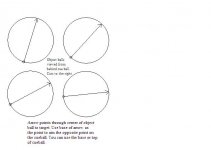Nice description Patrick.
This problem isn't unique to Johnny's method. Visualizing the ghost ball to create the perfect clock position is a complication that makes a system designed to be easy too hard to use. I'd say forget the ghost ball and just aim a little thicker as the cueball gets closer to the object ball. Or, if you find it easier, rather than pointing the arrow at the pocket, point it to a thinner cut area on the rail as necessary.
This problem isn't unique to Johnny's method. Visualizing the ghost ball to create the perfect clock position is a complication that makes a system designed to be easy too hard to use. I'd say forget the ghost ball and just aim a little thicker as the cueball gets closer to the object ball. Or, if you find it easier, rather than pointing the arrow at the pocket, point it to a thinner cut area on the rail as necessary.
